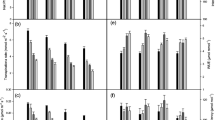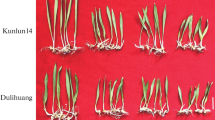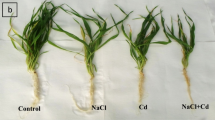Abstract
The toxicity of many heavy metals in plants is closely associated with its subcellular distribution and chemical forms. The subcellular distribution and chemical forms of cobalt (Co2+) were investigated using 3 barley genotypes differing in Co2+ toxicity resistance, namely Yan66 (resistant), Ea 52 (sensitive), and Humai 4 (moderate), under two Co2+ levels (25 and 100 µM). Higher Co2+ level in cultural solution significantly increased Co2+ accumulation in all subcellular fractions, with vacuole and cell wall having higher concentration. In comparison with 25 µM Co2+, 100 µM Co2+ treatment caused significant increase of Co2+ concentration in the forms of F-NaCl (extracted with 1 M NaCl), F-Ac (extracted with 2% HAc), F-HCl (extracted by 0.6 M HCl), and F-residue (residue forms) in both shoots and roots. There was a significant difference among genotypes in Co2+ subcellular distribution and chemical forms, with Ea52 accumulating more Co2+ in organelles and Yan66 accumulating more Co2+ in vacuole and cell wall. Moreover, the inorganic form of Co2+ extracted with 80% ethanol (F-ethanol) and water-soluble form (F-H2O) were significantly increased in Ea52, while Yan66 accumulated more Co2+ in the forms of low-bioavailable molecules (F-NaCl, F-HAc, and F-HCl). The results suggest that the vacuolar sequestration and cell wall deposition of Co2+ is a key resistant mechanism for genotype Yan66.






Similar content being viewed by others
References
Abbasi SA, Nipaney PC, Soni R (1989) Environmental status of cobalt and its micro determination with 7-nitroso-8-hydroxyquinoline-5-sulfonic acid in waters, aquatic weeds and animal tissues. Anal Lett 22:225–235
Brune A, Urbach W, Dietz KJ (1995) Differential toxicity of heavy metals is partly related to a loss of preferential extra plasmatic compartmentation: a comparison of Cd, Mo, Ni, and Zn stress. New Phytol 129:403–409
Chatterjee J, Chatterjee C (2003) Management of phytotoxicity of cobalt in tomato by chemical measures. Plant Sci 164:793–801
Dalvi AA, Bhalerao SA (2013) Response of plants towards heavy metal toxicity: an overview of avoidance, tolerance and uptake mechanism. Ann Plant Sci 2:362–368
Dawson RMC, Elliott DC, Elliott WH, Jones KM (1986) Data for biochemical research, 3rd edn. Clarendon Press, Oxford
Gupta UC, Gupta SC (1998) Trace element toxicity relationships to crop production and livestock and human health: implications for management. Commun Soil Sci Plant Anal 29:1491–1522
Hayens RJ (1980) Ion exchange properties of roots and ionic interactions within the root POPLsm: their role in ion accumulation by plants. Bot Rev 46:75–99
Herselman JE (2007) The concentration of selected trace metals in South African soils, PhD thesis. University of Stellenbosch, South Africa
Karuppanapandian T, Kim W (2013) Cobalt-induced oxidative stress causes growth inhibition associated with enhanced lipid peroxidation and activates antioxidant responses in Indian mustard (Brassica juncea L.) leaves. Acta Physiol Plant 35:2429–2443
Krämer U, Ingrid JP, Roger CP, Raskin I, Salt DE (2000) Subcellular localization and speciation of nickel in hyperaccumulator and non-accumulator Thlaspe species. Plant Physiol 122:1343–1353
Liu J, Duan CQ, Zhang XH, Zhu YN, Hu C (2009) Subcellular distribution of chromium in accumulating plant Leersia hexandra Swartz. Plant Soil 322:187–195
Lwalaba JL, Gerald Z, Mwamba TM, Mukobo RPM, Zhang GP (2017) The effect of cobalt stress on growth and physiological traits and its association with cobalt accumulation in barley genotypes differing in cobalt tolerance. J Plant Nutr (in press)
Ma JF, Zheng SJ, Matsumoto H (1997) Detoxifying aluminum with buckwheat. Nature 390:569–570
Merian E (1985) Introduction on environmental chemistry and global cycles of chromium, nickel, cobalt, beryllium, arsenic, cadmium and selenium, and their derivatives. Environ Toxicol Chem 8:3–32
Patra M, Bhowmik N, Bandopadhyay B, Sharma A (2004) Comparison of mercury, lead and arsenic with respect to genotoxic effects on plant systems and the development of genetic tolerance. Environ Exp Bot 52:199–223
Peng HY, Yang XE, Tian SK (2005) Accumulation and ultrastructural distribution of copper in Elsholtzia splendens. J Zhejiang Univ Sci B 6:311–318
Peralta-Videa JR, Lopez ML, Narayan M, Saupe G, Gardea-Torresdey J (2009) The biochemistry of environmental heavy metal uptake by plants: implications for the food chain. Int J Biochem Cell Biol 41:1665–1677
Rajeev G, Dube BK, Pratima S, Chatterjee C (2003) Cobalt toxicity effects on growth and metabolism of tomato. Commun Soil Sci Plant Anal 34:619–628
Ramsay LM, Gadd GM (1997) Mutants of Saccharomyces cerevisiae defective in vacuolar function confirm a role for the vacuole in toxic metal ion detoxification. FEMS Microbiol Lett 152:293–298
Salt DE, Prince RC, Baker AJM, Raskin I, Pickering IJ (1999) Zinc ligands in the metal hyper accumulator Thlaspi caerulescens as determined using x-ray absorption spectroscopy. Environ Sci Technol 33:713–717
Smith IC, Carson BL (1981) Trace metals in the environment. Science Publishers, Ann Arbor
Sokolova IM, Ringwood AH, Johnson C (2005) Tissue-specific accumulation of cadmium in subcellular compartments of eastern oysters Crassostrea virginica Gmelin (Bivalvia: Ostreidae). Aquat Toxicol 74:218–228
Sree KS, Appenroth KJ (2015) Phytotoxicity of cobalt ions on the duckweed Lemna minor—morphology, ion uptake, and starch accumulation. Chemosphere 131:149–156
Vanselow AP (1965) Cobalt. In: Chapman HD (ed) Diagnostic criteria of plants. Quality Printing Company, Abilene, pp 142–156
Vazquez MD, Barcelo J, Poschenrieder C, Madico J, Hatton P, Baker AJM, Cope GH (1992) Localization of zinc and cadmium in Thlaspi caerulescens (Brassicaceae), a metallophyte that can hyperaccumulate both metals. J Plant Physiol 140:350–355
Viehweger K (2014) How plants cope with heavy metals. Bot Stud 55:1–12
Vogeli-Lange R, Wagner GJ (1990) Subcellular localization of cadmium and cadmium-binding peptides in tobacco leaves. Plant Physiol 92:1086–1093
Wang X, Liu YG, Zeng MM, Chai LY, Song XC (2008) Subcellular distribution and chemical forms of cadmium in Bechmeria nivea (L.) Gaud. Environ Exp Bot 62:389–395
Wu FB, Dong J, Qian QQ, Zhang GP (2005) Subcellular distribution and chemical form of Cd and Cd-Zn interaction in different barley genotypes. Chemosphere 60:1437–1446
Yang JR, He JQ, Zhang GX, Mao XQ (1995) Tolerance mechanism of crops to Cd pollution. Chin J Appl Ecol 6:87–91
Zeng FR, Ali S, Zhang HT, Ouyang Y, Qiu BY, Wu FB, Zhang GP (2011a) The influence of pH and organic matter content in paddy soils on heavy metal availability and their uptake by rice plants. Environ Pollut 159:84–91
Zeng FR, Zhou WH, Qiu BY, Shafaqat A, Wu FB, Zhang GP (2011b) Subcellular distribution and chemical forms of chromium in rice plants suffering from different levels of chromium toxicity. J Plant Nutr Soil Sci 174:249–256
Zhang CL, Zhang P, Mo CR, Yang WW, Li QF, Pan LP, Lee DK (2013) Cadmium uptake, chemical forms, subcellular distribution, and accumulation in Echinodorus osiris Rataj. Environ Sci 15:1459–1465
Acknowledgements
This research was supported by the Natural Science Foundation of China (31330055) and China Agriculture Research System (CARS-05).
Author information
Authors and Affiliations
Corresponding author
Additional information
Communicated by E Schleiff.
Rights and permissions
About this article
Cite this article
Lwalaba, J.L.W., Zvobgo, G., Mwamba, M. et al. Subcellular distribution and chemical forms of Co2+ in three barley genotypes under different Co2+ levels. Acta Physiol Plant 39, 102 (2017). https://doi.org/10.1007/s11738-017-2400-2
Received:
Revised:
Accepted:
Published:
DOI: https://doi.org/10.1007/s11738-017-2400-2




